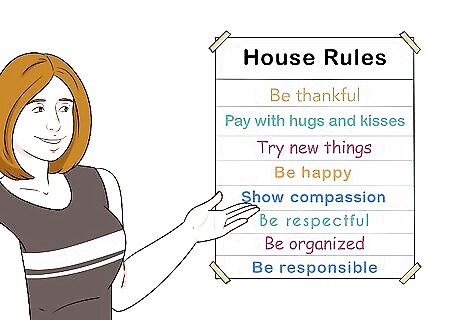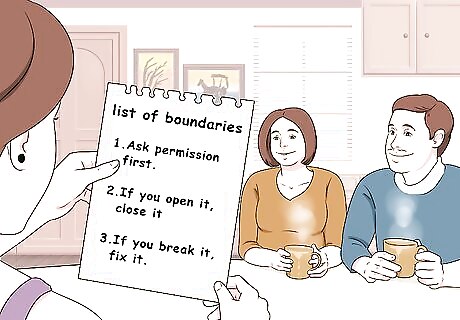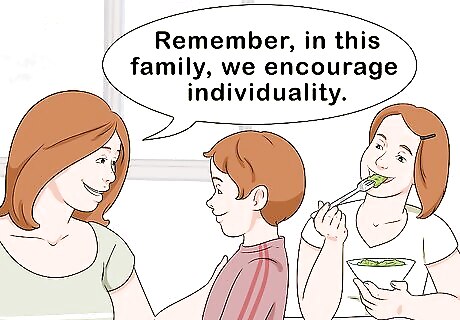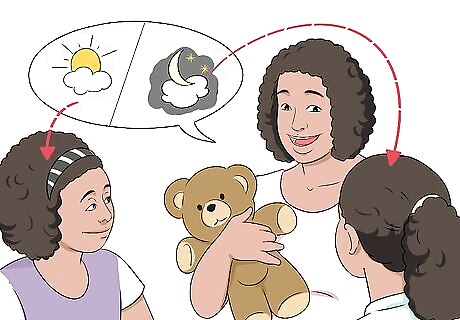
views
Encouraging Cooperation

Communicate and enforce household rules. The rules you set in your household are the foundation for how everyone in the family interacts and relates to one another. These rules provide structure about how your children should or shouldn’t behave. Clearly communicate the standards you expect from your children and enforce them when necessary. Make the ground rules a part of the fabric of your home life. Post them in common places and frequently refer your children to them when rules are broken. Make sure that both the rules and the consequences for breaking each rule are clearly stated, and that everyone understands them. Set a good example for your kids by following the rules, as well as enforcing them.

Stress the significance of family relationships. The attitude you portray about family can boost your children’s chances of getting along. Share an expectation that they should have positive relationships with one another because they are family. Do this from an early age. Relationships with other kids their age is important. However, you should also set the expectation that siblings should be friends, too.
Plan family activities. Promote family bonding by creating plentiful opportunities for your kids to have fun together. Make sure siblings play together, do activities together, and support one another’s hobbies and interests. Get your kids more interested in family activities by involving them in the planning. If your kids disagree about what kinds of activities they want to do together, encourage them to compromise.

Initiate family meetings. If your children are old enough to discuss their experiences in the family, start having regular meetings. During this time, the floor should be open for everyone to express their thoughts and opinions about what’s happening in the household. Use these meetings as a platform to isolate problems and work together to devise solutions. Establish some ground rules for these meetings, such as everyone should get a chance to talk (respectfully) and everyone else must listen without interrupting.

Encourage all the children to set personal boundaries. Boundaries are a necessary element in all healthy relationships, sibling relationships included. In a family meeting, introduce the topic of personal boundaries and have each child develop a reasonable list of boundaries to share with the family. For example, if a sibling wants to borrow something, a boundary might be to ask permission first. If permission isn’t granted or asked and the person borrows something anyway, the boundary has been violated. You can also talk to your kids about setting personal space boundaries. For example, you might make it a rule that everyone has to knock before entering someone else’s bedroom, and that requests for privacy must be respected. Emphasize the importance of others respecting these boundaries. Encourage children to enforce their boundaries with one another before involving a parent.

Promote and praise teamwork. Offer opportunities for your children to work as a team, such as washing the dishes together or picking up toys together. This helps cooperation become more natural for them. When you see them cooperating with one another, reinforce the positive behavior with praise. For instance, you might say, “It’s so wonderful to see you two working on that puzzle together.” You might even treat them when you see them working as a team.

Encourage them to accept individual differences. As your children become older, they will start to develop more of an identity beyond the family. Support their identity development by allowing them to go through different phases without harsh criticism from the rest of the family. For example, if your teen daughter decides to become a vegetarian, discourage your son from teasing her with meat at dinner. To help encourage this, you might repeat a phrase like "Remember, in this family, we encourage individuality."
Teaching Conflict Resolution

Identify solutions to recurring conflicts. Work with your children to identify recurring issues and then develop strategies to avoid them. Sit down and figure out ways they can stop these situations before they occur. Solving these conflicts can help them get along better. For example, if two siblings often have issues sharing a toy, you might assign the toy to one child in the morning and the other child in the afternoon to eliminate the problem. Another example might be having one child politely approach the other sibling to ask to play instead of starting a fight to get their attention.

Coach passive children to speak up for themselves. If one child seems to have trouble standing up to their siblings, help them find their voice. That way, you won’t need to step in as much and they can resolve conflicts on their own. For instance, you might say, “Robin, what’s wrong?” Robin: “Jared took my toy.” You: “Jared, can you ask before taking her toy?” You: “Robin, next time, I need you to speak up and tell him yourself, okay?”

Applaud their efforts at conflict resolution. When children solve their problems on their own, parents aren’t forced to jump in and pick a side. If you spot one child or several children working to resolve a problem without you, encourage the behavior. You might say something like, “I like how you just communicated your boundary, Vanessa. Doing that helps your sister know when she’s gone too far without turning it into a fight.” Applaud any attempts your children make at using positive methods to problem-solve.

Discourage tattling. A good rule of thumb is to let children work out their own disagreements. This helps them develop communication and assertiveness skills. It also benefits their maturity. To encourage a desire to work out problems on their own, try to reduce their tendency to run to you and tattle. For example, you might express a desire for them to work out problems on their own. If they run to you, you might ignore the tattling on purpose. Then, when they try to resolve the problem, praise their attempt. If one child runs to you to tell on their sibling, you might ask, “And, what are you going to do about that?” to inspire their problem-solving strategies. Intervene only when necessary, such as when someone is hurt or in harm’s way.
Put a stop to bullying. If one of your kids is bullying their sibling, take control of the situation as quickly as possible. Bullying might take the form of mocking, hurtful name-calling, harassment, or physical violence (such as hitting, kicking, hair-pulling, or biting). Tell the child who is doing the bullying that their behavior is unacceptable. For example, you might say, “What you’re doing is not ok. I will not allow you to hit your brother, ever.” Establish clear consequences for bullying behaviors, and enforce them consistently. Think about where they bullying behavior might be coming from. Is your child dealing with a difficult situation and taking their anger out on their sibling? Is someone at home or school modeling bullying behavior? If you’re unable to stop the behavior on your own, consider talking to your child’s physician or a counselor.
Doing Your Part

Model the behavior you desire. As a parent, it’s important that you set a good example for your children to follow. If you are serious about them getting along, be sure to demonstrate good communication skills, set healthy boundaries, and resolve your own conflicts in positive ways. Use phrases you’d like your children to use, like “please” and “thank you.”
Be consistent with rewards and consequences. If you’ve established rules for behavior, it is very important to be consistent about enforcing those rules and following through on consequences. Remember to consistently praise and reward positive behaviors, as well. Establishing a system of rewards is the most effective way to encourage behaviors that you want.

Ensure that each child has personal space. Teens, especially, are more concerned about having a private space to call their own. Even if some of your children share rooms, help them build separate personal spaces. Then, communicate rules about respecting personal space to all your children. For instance, if children share a room, you might set up a schedule where each child has the room to themselves to play with friends or do activities for an hour every day. Provide the other child another space to use during this time. If they have separate rooms, you might communicate a rule like "Knock on your sister's/brother's door before entering" to respect each child's personal domain.

Be a good listener. Sometimes, kids just want to vent and know that they are being heard. Give them the opportunity to do this in a safe place by demonstrating good listening skills. Don’t be so quick to offer a solution or redirect your kids. Let them talk out their problems and see if they’ll reach a natural conclusion on their own. Acknowledge and validate their feelings by saying things like “Aww, that sounds difficult” when they complain about sibling frustrations.

Avoid comparing your kids to each other or their peers. When you compare your kids to one another, you introduce a need to compete. Every kid has something special and unique about them, so don’t measure them up against their siblings or other kids. For example, you shouldn't say, "See, Charlie? Your brother always puts his toys away once he's done with them. Why can't you do that?" A better solution would be to praise the child for cleaning up his toys in hopes that it would reinforce the other child doing the same. Not drawing comparisons is perhaps one of the most effective strategies you can use to help your children get along.

Give each child individual attention and love. Develop a unique bond with each of your children. Then, they won’t feel such pressure to compete with their siblings for your attention or adoration. Highlight each child’s needs and try to meet them by setting aside one-on-one time with each of them throughout the week. For instance, if you have a creative child, you might sit down to paint or draw with them. Whereas, if you have an athletic child, you might toss a ball around and chat.




















Comments
0 comment